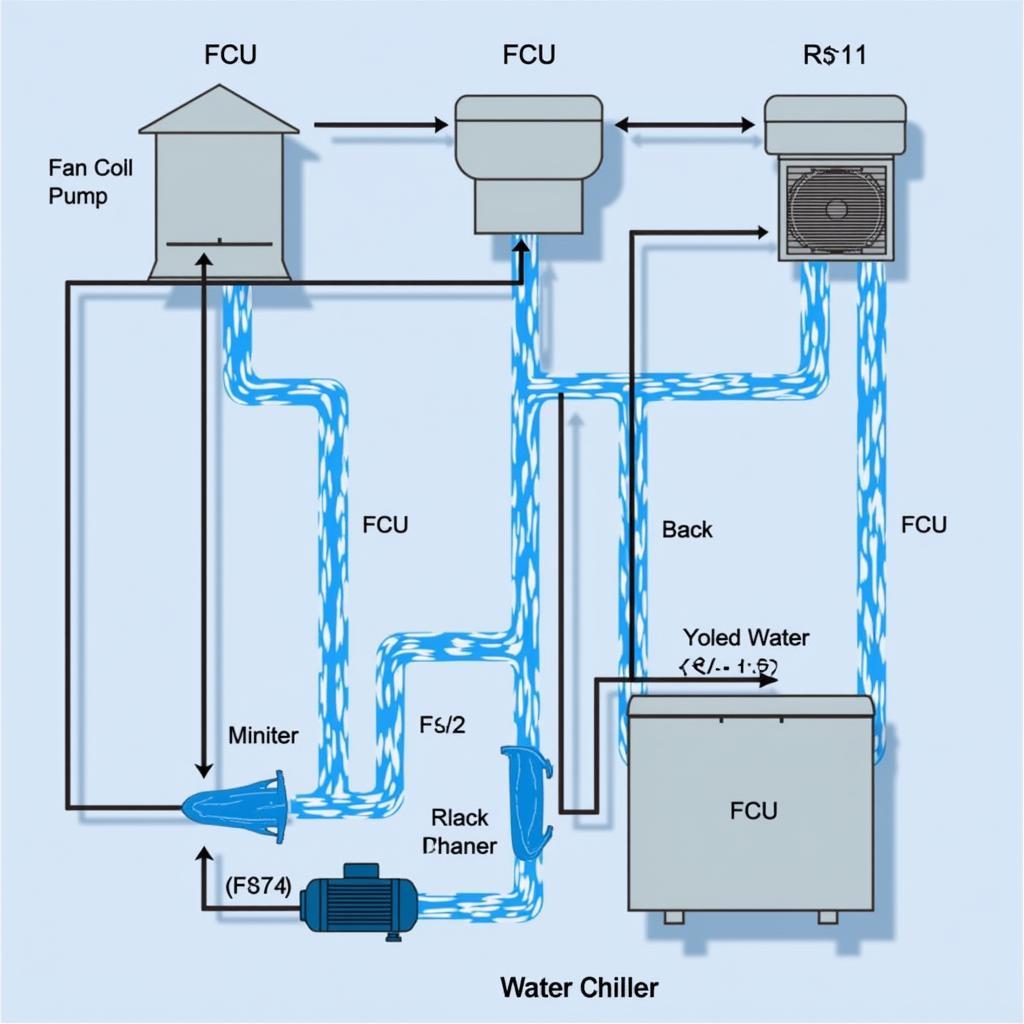A fan coil unit (FCU) and water chiller system is a popular choice for providing cooling and heating solutions in residential and commercial buildings. This system offers energy efficiency, individual temperature control, and a comfortable indoor environment. Understanding the connection between an FCU fan coil unit and water chiller is essential for installation, maintenance, and troubleshooting. This article will provide a comprehensive guide to the FCU fan coil unit and water chiller connection diagram, explaining the components, their functions, and the flow of chilled and hot water within the system.
Components of an FCU Fan Coil Unit and Water Chiller System
Before delving into the connection diagram, it’s crucial to understand the key components involved:
1. Water Chiller: The water chiller is the heart of the system, responsible for cooling the water that circulates throughout the building. It uses a refrigerant cycle to extract heat from the water, similar to how a refrigerator works.
2. FCU Fan Coil Unit: The FCU fan coil unit is installed inside the room and acts as the delivery point for the chilled or heated water. It consists of a fan, a coil (heat exchanger), and a filter.
3. Chilled Water Pump: This pump circulates the chilled water from the chiller to the FCUs.
4. Condenser Water Pump: This pump circulates the condenser water, which absorbs heat from the refrigerant in the chiller and dissipates it outside the building (often through a cooling tower).
5. Expansion Tank: The expansion tank accommodates the changes in water volume due to temperature fluctuations, preventing pressure buildup in the system.
6. Piping and Valves: A network of pipes connects the chiller, pumps, and FCUs. Valves control the flow of water, allowing for individual room temperature regulation.
The FCU Fan Coil Unit and Water Chiller Connection Diagram
 FCU and Water Chiller Connection Diagram
FCU and Water Chiller Connection Diagram
The connection diagram typically involves two separate water loops:
1. Chilled Water Loop:
- Chilled water exits the chiller and is pumped through the chilled water supply pipe.
- The chilled water enters the FCU through the inlet valve.
- Inside the FCU, the chilled water flows through the coil.
- The fan blows air over the coil, cooling the air and distributing it into the room.
- The warmed water then exits the FCU and returns to the chiller through the chilled water return pipe.
2. Condenser Water Loop:
- The condenser water pump circulates water through the condenser within the chiller.
- Heat from the refrigerant is transferred to the condenser water.
- The heated condenser water is then pumped to a cooling tower or other heat rejection system outside the building.
- The cooled condenser water returns to the chiller to continue the cycle.
How the System Works
When the room thermostat signals a need for cooling, the FCU fan turns on, drawing warm air from the room over the chilled water coil. The chilled water absorbs the heat from the air, cooling it down. The cooled air is then blown back into the room, effectively lowering the room temperature.
Importance of Proper Connection and Maintenance
A correctly installed and well-maintained FCU fan coil unit and water chiller system offer numerous benefits:
- Energy Efficiency: The system efficiently cools or heats only the occupied spaces, minimizing energy waste.
- Individual Temperature Control: Each FCU operates independently, allowing occupants to adjust the temperature according to their preferences.
- Improved Indoor Air Quality: The filter within the FCU traps dust and other airborne particles, improving indoor air quality.
Expert Insight:
“Regular maintenance is crucial for optimal system performance and longevity. This includes cleaning or replacing FCU filters, checking refrigerant levels, and inspecting the pumps and valves.” – John Miller, HVAC Technician
Troubleshooting Common Issues
While the system is generally reliable, understanding common issues can help in troubleshooting:
1. Insufficient Cooling: This could be due to a clogged filter, low refrigerant charge, or a malfunctioning pump.
2. Water Leaks: Leaks can occur from pipe connections, valves, or the FCU itself. Regular inspection and maintenance can prevent these issues.
3. Noisy Operation: Unusual noises from the FCU could indicate a failing fan motor, worn bearings, or loose components.
Conclusion
The FCU fan coil unit and water chiller connection diagram provides a roadmap for understanding how these systems operate. From the chiller’s cooling power to the FCU’s individualized temperature control, each component plays a vital role in achieving efficient and comfortable indoor environments. By understanding the connection and ensuring proper maintenance, building owners and occupants can enjoy the numerous benefits of this versatile HVAC system.
FAQs
1. What is the purpose of an expansion tank in this system?
The expansion tank accommodates the changes in water volume due to temperature fluctuations, preventing pressure buildup and potential damage to the system.
2. How often should I clean or replace the FCU filter?
It’s recommended to clean or replace the FCU filter every 1-3 months, depending on usage and the surrounding environment.
3. Can I install an FCU fan coil unit and water chiller system myself?
It’s highly recommended to hire a qualified HVAC technician for installation to ensure proper sizing, connection, and refrigerant handling.
4. What is the typical lifespan of a water chiller?
With proper maintenance, a water chiller can last for 15-20 years or more.
5. What should I do if my FCU is leaking water?
Turn off the FCU and the water supply to the unit. Contact a qualified HVAC technician to diagnose and repair the leak.
Need Further Assistance?
For any further questions or assistance regarding FCU fan coil unit and water chiller systems, please contact us at:
Phone Number: 0903426737
Email: fansbongda@gmail.com
Address: To 9, Khu 6, Phuong Gieng Day, Thanh Pho Ha Long, Gieng Day, Ha Long, Quang Ninh, Vietnam.
Our dedicated customer support team is available 24/7 to assist you.


